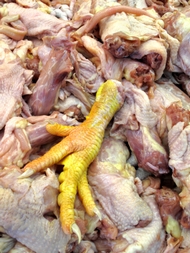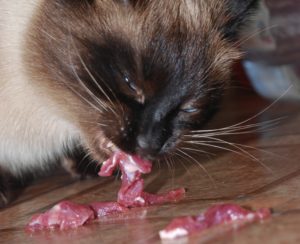Deceitful Marketing By Pet Food Companies
Marketing, money, and pet food
We’ve all heard the expression “it’s all in how you spin it.” Marketing agencies and departments are paid lots of money to figure out how to get people to drop their hard-earned money on products, and we see slick advertising campaigns everyday on TV. In fact, we see the same marketing messages and commercials so often that we subconsciously even buy into what they’re selling us. It becomes the “norm” and “accepted” just because it’s been drilled into our heads for so long! As cat parents it’s up to us to somehow sift through all the marketing hype and cute commercials with beautiful, playful, hungry cats that ultimately drive us to the store to purchase cat food. Why do we buy it? Because of the beautiful photos on the package? The cute commercial with the jingle you can’t forget? Pet food companies are notorious for appealing to the pet owner’s heartstrings and weakness for marketing creativity. They hope we take their messages at face value–on trust–that they know what’s best for our cat’s health when it comes to their food. But do they really? Why do we put so much trust in a particular pet food or brand?
Appearances can be deceiving and pet food marketing messages are ultimately about getting people to spend money. Pet food companies are counting on the fact that as cat parents we know nothing about feline nutrition and it should be left up to them to tell us what to feed our cats. The waters can be very muddied indeed, and it’s about to get even muddier. I just read an article in a pet food industry journal (www.petfoodindustry.com) that’s very disturbing. It discusses a proposed idea of using discarded and unwanted food scraps from the human industry as novel proteins in pet food.
A study on by-products

Chicken meat by products
A recent study on whether “consumers will accept food products made from discarded ingredients could have implications and lessons for pet food. That may be particularly true for pet food ingredients such as by-products” and waste from the human food industry. In other words, should pet food companies start using products that people won’t eat in their pet foods? And if they do they’ll need to put a new “spin” on how they market these to consumers in order to get them to “buy into it.”
“There is an economic, environmental and cultural argument for keeping food, when possible, as food and not trash,” said Jonathan Deutsch, PhD, professor in Drexel’s Center for Food and Hospitality Management. “Converting surplus foods into value-added products will feed people, create opportunities for employment, entrepreneurship and lower the environmental impact of wasted resources.”
When it comes to pet food these implications are huge.
It may depend on how they are marketed as ingredients — to pet food companies as well as to consumers. That’s the case for meat by-products as well. With the pet food industry competing directly with human food for animal-based protein ingredients, these organ and intestinal meat components are perfect for pet food and the pets that eat it, and they offer a very available and sustainable alternative. The issue is that many consumers won’t even consider buying pet foods with meat by-products because they’ve been led to believe the ingredients are unhealthy, unsafe and poor quality, even roadkill.
Great nutrition vs inferior nutrition
While this theory sounds plausible we must remember that just because a food can be considered a “protein” doesn’t mean it’s in the highest and best good of pets to eat it. There’s a huge difference between a food that provides great nutritional value and a food that is inferior.
One industry expert, “Ryan Yamka, PhD, founder of Luna Science and Nutrition and past R&D executive with several pet food companies, has posted charts showing how the protein and amino acid digestibility of meat and meat by-product meals ranks favorably with that of whole meats (as does corn gluten meal, for that matter), and that some of those meals have higher amino acid crude protein levels on an as-fed basis.
Yamka has also noted a resurgence in declaring the use of meat by-products. “New companies have found novel ways to market and glamorize these ingredients by calling them out individually,” he wrote. “While at a recent trade show, I saw companies calling out green tripe* (stomach lining), livers, gizzards, lung and blood as ingredients in their foods or treats. I even saw dehydrated rabbit feet, duck heads, duck feet, turkey tails and turkey fries. I guess it all comes down to marketing sometimes!”
Buy low, sell high
The article went on to suggest that value added surplus products discarded from the human food industry
may offer a path to the “next big thing” for premium pet food. The Drexel researchers studying them for human foods believe that selling them could prove lucrative. “Depending upon how you communicate such products, they might also be able to fetch a price premium, like those afforded to organic foods,” said Rajneesh Suri, PhD, professor in the LeBow College of Business.
Not only will pet food manufacturers be able to buy these kinds of products at a great price (because nobody wants them), they’ll most likely try and sell them at a premium because the word “novel” makes them sound more expensive.
Will you be pet food fooled?
I always refer back to carnivores in the wild. When they eat prey do they just eat the stomach linings, intestines, fur, feet and tails? Do such animal parts provide the best nutritional value? Do they substitute a meat-based diet for a grain-based diet that has a decent amount of plant protein? No! They prefer the organs, bones, and muscle meat. Animals instinctively know what they need to eat to be healthy and thrive.
 In other words, it’s all about how you “spin it.” If pet food companies can produce beautiful packages, heart-tugging commercials and throw in a message that “sounds good” to the consumer, chances are pet parents will buy it. If they can convince you that discarded animal and plant leftovers are superior in nutrition than real meat proteins your cat will lose. Don’t be fooled! Learn to read your cat food labels. The first ingredient should be real meat–not meat by-products, meat meal, corn products or other grains, legumes, or potatoes.
In other words, it’s all about how you “spin it.” If pet food companies can produce beautiful packages, heart-tugging commercials and throw in a message that “sounds good” to the consumer, chances are pet parents will buy it. If they can convince you that discarded animal and plant leftovers are superior in nutrition than real meat proteins your cat will lose. Don’t be fooled! Learn to read your cat food labels. The first ingredient should be real meat–not meat by-products, meat meal, corn products or other grains, legumes, or potatoes.
Your cat’s health should never be sacrificed just for the sake of sustainability or corporate responsibility. Now more than ever we need to be more vigilant when it comes to ingredients pet food companies are putting into pet food. Otherwise we’re sure to fall for clever marketing schemes and our cats will ultimately pay the price with their health.
Want to learn more about optimal nutrition for your cat? Check out this page. Share this on your favorite social channels!


